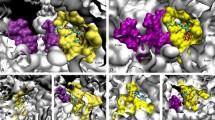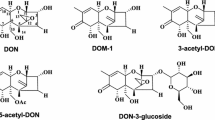Abstract
Patulin is the main mycotoxin contaminating apples. During the brewing of alcoholic beverages, this mycotoxin is degraded to ascladiol, which is also the last precursor of patulin. The present study aims (1) to characterize the last step of the patulin biosynthetic pathway and (2) to describe the toxicity of ascladiol. A patE deletion mutant was generated in Penicillium expansum. In contrast to the wild strain, this mutant does not produce patulin but accumulates high levels of E-ascladiol with few traces of Z-ascladiol. This confirms that patE encodes the patulin synthase involved in the conversion of E-ascladiol to patulin. After purification, cytotoxicities of patulin and E- and Z-ascladiol were investigated on human cell lines from liver, kidney, intestine, and immune system. Patulin was cytotoxic for these four cell lines in a dose-dependent manner. By contrast, both E- and Z-ascladiol were devoid of cytotoxicity. Microarray analyses on human intestinal cells treated with patulin and E-ascladiol showed that the latter, unlike patulin, did not alter the whole human transcription. These results demonstrate that E- and Z-ascladiol are not toxic and therefore patulin detoxification strategies leading to the accumulation of ascladiol are good approaches to limit the patulin risk.






Similar content being viewed by others
References
Alberts JF, Engelbrecht Y, Steyn PS, Holzapfel WH, van Zyl WH (2006) Biological degradation of aflatoxin B1 by Rhodococcus erythropolis cultures. Int J Food Microbiol 109:121–126
Artigot MP, Loiseau N, Laffitte J, Mas-Reguieg L, Tadrist S, Oswald IP, Puel O (2009) Molecular cloning and functional characterization of two CYP619 cytochrome P450 s involved in biosynthesis of patulin in Aspergillus clavatus. Microbiology 155:1738–1747
Beck J, Ripka S, Siegner A, Schiltz E, Schweizer E (1990) The multifunctional 6-methylsalicylic acid synthase gene of Penicillium patulum. Its gene structure relative to that of other polyketide synthases. Eur J Biochem 192:487–498
Caiazzo R, Kim YK, Xiao CL (2014) Occurrence and phenotypes of pyrimethanil resistance in Penicillium expansum from apple in Washington state. Plant Dis 98:924–928
Castoria R, Mannina L, Duran-Patron R, Maffei F, Sobolev AP, De Felice DV, Pinedo-Rivilla C, Ritieni A, Ferracane R, Wright SA (2011) Conversion of the mycotoxin patulin to the less toxic desoxypatulinic acid by the biocontrol yeast Rhodosporidium kratochvilovae strain LS11. J Agric Food Chem 59:11571–11578
Devi P, Naik CG, Rodrigues C (2006) Biotransformation of citrinin to decarboxycitrinin using an organic solvent-tolerant marine bacterium, Moraxella sp. MB1. Mar Biotechnol 8:129–138
Dijkman WP, Fraaije MW (2014) Discovery and characterization of a 5-hydroxymethylfurfural oxidase from Methylovorus sp. strain MP688. Appl Environ Microbiol 80:1082–1090
Dong X, Jiang W, Li C, Ma N, Xu Y, Meng X (2015) Patulin biodegradation by marine yeast Kodameae ohmeri. Food Addit Contam Part A Chem Anal Control Expo Risk Assess 32:352–360
El-Sharkaway SH, Selim MI, Afifi MS, Halaweish FT (1991) Microbial transformation of zearalenone to a zearalenone sulfate. Appl Environ Microbiol 57:549–552
Errampalli D, Brubacher NR, DeEll JR (2006) Sensitivity of Penicillium expansum to diphenylamine and thiabendazole and postharvest control of blue mold with fludioxonil in ‘McIntosh’ apples. Postharvest Biol Technol 39:101–107
Etxebeste O, Herrero-García E, Cortese MS, Garzia A, Oiartzabal-Arano E, De los Ríos V, Ugalde U, Espeso EA (2012) GmcA is a putative glucose–methanol–choline oxidoreductase required for the induction of asexual development in Aspergillus nidulans. PLoS ONE 7:e40292
Fliege R, Metzler M (2000a) Electrophilic properties of patulin. Adduct structures and reaction pathways with 4-bromothiophenol and other model nucleophiles. Chem Res Toxicol 13:363–372
Fliege R, Metzler M (2000b) Electrophilic properties of patulin. N-acetylcysteine and glutathione adducts. Chem Res Toxicol 13:373–381
Glaser N, Stopper H (2012) Patulin: mechanism of genotoxicity. Food Chem Toxicol 50:1796–1801
Ianiri G, Idnurm A, Wright SA, Duran-Patron R, Mannina L, Ferracane R, Ritieni A, Castoria R (2013) Searching for genes responsible for patulin degradation in a biocontrol yeast provides insight into the basis for resistance to this mycotoxin. Appl Environ Microbiol 79:3101–3115
IARC (1986) Some naturally occuring and synthetic food components, furocoumarins and ultraviolet radiation. IARC Monogr Eval Carcinog Risks Hum 40:83–98
JECFA (1995) Evaluation of certain food additives and contaminants. Forty-fourth report of the joint FAO/WHO expert committee on food additives. WHO Tech Rep Ser 859:36–38
Kawauchiya T, Takumi R, Kudo Y, Takamori A, Sasagawa T, Takahashi K, Kikuchi H (2011) Correlation between the destruction of tight junction by patulin treatment and increase of phosphorylation of ZO-1 in Caco-2 human colon cancer cells. Toxicol Lett 205:196–202
Li H, Xiao C (2008) Characterization of fludioxonil-resistant and pyrimethanil-resistant phenotypes of Penicillium expansum from apple. Phytopathology 98:427–435
Mahfoud R, Maresca M, Garmy N, Fantini J (2002) The mycotoxin patulin alters the barrier function of the intestinal epithelium: mechanism of action of the toxin and protective effects of glutathione. Toxicol Appl Pharmacol 181:209–218
Maidana L, Gerez JR, El Khoury R, Pinho F, Puel O, Oswald IP, Bracarense AP (2016) Effects of patulin and ascladiol on porcine intestinal mucosa: an ex vivo approach. Food Chem Toxicol. doi:10.1016/j.fct.2016.10.001
McLaughlin J, Lambert D, Padfield PJ, Burt JP, O’Neill CA (2009) The mycotoxin patulin, modulates tight junctions in caco-2 cells. Toxicol In Vitro 23:83–89
Merhej J, Richard-Forget F, Barreau C (2011) The pH regulatory factor Pac1 regulates Tri gene expression and trichothecene production in Fusarium graminearum. Fungal Genet Biol 48:275–284
Morales H, Sanchis V, Coromines J, Ramos AJ, Marin S (2008) Inoculum size and intraspecific interactions affects Penicillium expansum growth and patulin accumulation in apples. Food Microbiol 25:378–385
Moss MO, Long MT (2002) Fate of patulin in the presence of the yeast Saccharomyces cerevisiae. Food Addit Contam 19:387–399
Pierron A, Mimoun S, Murate LS, Loiseau N, Lippi Y, Bracarense A-PF, Liaubet L, Schatzmayr G, Berthiller F, Moll W-D (2016) Intestinal toxicity of the masked mycotoxin deoxynivalenol-3-β-d-glucoside. Arch Toxicol 90:2037–2046
Puel O, Tadrist S, Galtier P, Oswald IP, Delaforge M (2005) Byssochlamys nivea as a source of mycophenolic acid. Appl Environ Microbiol 71:550–553
Puel O, Galtier P, Oswald IP (2010) Biosynthesis and toxicological effects of patulin. Toxins 2:613–631
Ricelli A, Baruzzi F, Solfrizzo M, Morea M, Fanizzi FP (2007) Biotransformation of patulin by Gluconobacter oxydans. Appl Environ Microbiol 73:785–792
Sekiguchi J, Shimamoto T, Yamada Y, Gaucher GM (1983) Patulin biosynthesis: enzymatic and nonenzymatic transformations of the mycotoxin (E)-ascladiol. Appl Environ Microbiol 45:1939–1942
Shao S, Zhou T, McGarvey BD (2012) Comparative metabolomic analysis of Saccharomyces cerevisiae during the degradation of patulin using gas chromatography-mass spectrometry. Appl Microbiol Biotechnol 94:789–797
Shoemaker RH, Curt GA, Carney DN (1983) Evidence for multidrug-resistant cells in human tumor cell populations. Cancer Treat Rep 67:883–888
Silva JC, Minto RE, Barry CE, Holland KA, Townsend CA (1996) Isolation and characterization of the versicolorin B synthase gene from Aspergillus parasiticus. Expansion of the aflatoxin b1 biosynthetic gene cluster. J Biol Chem 271:13600–13608
Snini SP, Tadrist S, Laffitte J, Jamin EL, Oswald IP, Puel O (2014) The gene PatG involved in the biosynthesis pathway of patulin, a food-borne mycotoxin, encodes a 6-methylsalicylic acid decarboxylase. Int J Food Microbiol 171:77–83
Snini SP, Tannous J, Heuillard P, Bailly S, Lippi Y, Zehraoui E, Barreau C, Oswald IP, Puel O (2016) Patulin is a cultivar-dependent aggressiveness factor favoring the colonization of apples by Penicillium expansum. Mol Plant Pathol 17:920–930
Steyn PS (1991) The biosynthesis of polyketide-derived mycotoxins. J Environ Pathol Toxicol Oncol 11:47–59
Suzuki T, Takeda M, Tanabe H (1971) A new mycotoxin produced by Aspergillus clavatus. Chem Pharm Bull 19:1786–1788
Tannous J, El Khoury R, Snini SP, Lippi Y, El Khoury A, Atoui A, Lteif R, Oswald IP, Puel O (2014) Sequencing, physical organization and kinetic expression of the patulin biosynthetic gene cluster from Penicillium expansum. Int J Food Microbiol 189:51–60
Wright SAI, Ianiri DVG, Felice D, Castoria R, Berolini P (2007) A rapid assay for patulin degradation by the basidiomycetous yeast Rhodotorula glutinis strain LS11. In: Novel approaches for the control of postharvest diseases and disorders. Proceedings of the International Congress. Bologna, Italy
Wu TS, Liao YC, Yu FY, Chang CH, Liu BH (2008) Mechanism of patulin-induced apoptosis in human leukemia cells (HL-60). Toxicol Lett 183:105–111
Acknowledgements
J. Tannous and S. Snini were supported by doctoral fellowship from CNRS and Saint-Joseph University, Lebanon and MESR, France, respectively. This work was supported by the project CASDAR AAP RT 2015 No. 1523. We thank C. Naylies (GeT-TRiX Genopole) for her excellent technical assistance, the Cell Imaging Platform (M2C, ToxAlim) and the bioinformatics platform (Bioinfo Genotoul).
Author information
Authors and Affiliations
Corresponding author
Ethics declarations
Conflict of interest
The authors declare that they have no conflict of interest.
Additional information
Joanna Tannous and Selma P. Snini have contributed equally to this work.
Electronic supplementary material
Below is the link to the electronic supplementary material.
Rights and permissions
About this article
Cite this article
Tannous, J., Snini, S.P., El Khoury, R. et al. Patulin transformation products and last intermediates in its biosynthetic pathway, E- and Z-ascladiol, are not toxic to human cells. Arch Toxicol 91, 2455–2467 (2017). https://doi.org/10.1007/s00204-016-1900-y
Received:
Accepted:
Published:
Issue Date:
DOI: https://doi.org/10.1007/s00204-016-1900-y




